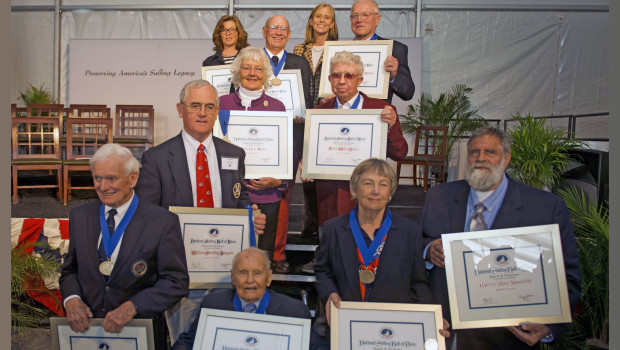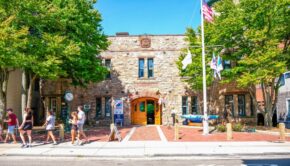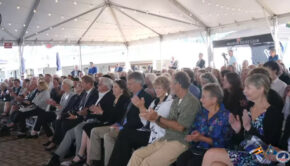Hall of Fame Inducts Ten of Sailing’s Significant Contributors
Published on October 28th, 2013
Annapolis, MD (October 28, 2013) – The U.S. National Sailing Hall of Fame (NSHOF) inducted ten of the sport’s significant contributors into the National Sailing Hall of Fame during ceremonies held for the first time in the organization’s hometown, and on the site of its future facility at City Dock in the historic waterfront district of Annapolis. The previous induction ceremonies – reflecting the national scope of the organization – were held in San Diego and New Orleans.
The 2013 NSHOF Induction Ceremony, held Sunday, October 27, was dedicated to the United States Naval Academy, with whom the NSHOF has partnered in its quest to preserve America’s sailing legacy, embed sailing in education, and recognize sailing’s heroes.
“At the Naval Academy we view sailing as the best platform for leadership development,” said Commander Les Spanheimer, Director of Naval Academy Sailing. “Our midshipmen will soon be thrown into some very dynamic situations as naval aviators, surface warfare officers, submariners, Navy Seals and Marine officers. It is onboard a sailboat that they get practical experience working as a crew… and they learn a complex set of skills and subject matter expertise.” In thanking the NSHOF for dedicating the ceremony to the Academy, Spanheimer added: “Whether we’re preserving our nation’s nautical history or developing our nation’s future leaders under sail, I think our purposes intersect quite nicely.”
Six living sailing legends were celebrated for their impact on the sport.
Three-time U.S. Women’s Sailing Champion “Timmy” Larr (Oyster Bay, N.Y.) is only the second woman, to date, to be inducted into the National Sailing Hall of Fame. “To be even considered to be in this group of superstars… it’s unbelievable. Thank you,” said Larr, a two-time Yachtswoman of the Year (1961, 1965). “I stand here to accept this honor not for me, but for all the teams I’ve worked with. I couldn’t have done anything without my crews; we were always a team. I may have been recognized for the honor, but it was they who actually made it all happen.”
A naval architect, Larr’s competitive accomplishments in the 1960s put her in the forefront of the sport at a time when it was rare to see a woman at the top of the podium. More recently, her pioneering contributions in standardizing the sail training program in the U.S. was the catalyst for similar programs for judges and race committee officials.
She established the National Junior Sailing Symposium, and assisted in the formulation of the Small Boat and Keelboat Certification Systems, as well as the new Powerboat Program. She also co-authored or contributed to the textbooks and instructor manuals used in the Certification Systems. Her efforts in maintaining high quality standards for sail training have earned the programs the respect of the US Coast Guard, US Power Squadron and the National Association of State Boating Law Administrators. These systems have helped thousands of people of all ages to learn to race, cruise, teach and coach – always with safety a paramount consideration. She was awarded the Nathanael G. Herreshoff Trophy – for outstanding contribution to the sport – by US Sailing in 1992.
Best known in sailing circles as a three-time Star World Champion (1961, ’70, ’85) and 1984 Star Olympic Gold Medalist, Bill Buchan (Medina, Wash.), can also lay claim to Olympic sports trivia: he was 49 years old in 1984, making him the oldest member of the entire US Olympic Team across all sports; and as he won his gold medal in the Star class, his son, Carl Buchan, was winning one in the Flying Dutchman class at the same Games.
“If it wasn’t for Seattle Yacht Club arranging for the 1948 Star North Americans, I wouldn’t be standing here today,” said Buchan whose parents had immigrated to Seattle from Scotland in the early 1920s to work in the fishing industry. When the Star caught Bill’s eye, his father, who built houses and boats in his spare time, built a Star for his son and then crewed for him. By the time they built a third boat, they had figured out how to make it fast. By 1954 Bill had become a builder of record for the Star class; the improvements he has made to the build process over the years are evident in the use of the Buchan hull shape by current-day builders. “After I won the worlds in 1961, my dad said to me – luckily one of the few pieces of advice from my dad that I did not take – he said ‘that’s as good as it’s gonna get, I think you should quit sailing now.’ Thank goodness I didn’t take that [advice].”
The sailing resume of Dave Curtis (Marblehead, Mass.), a two-time ICSA All-American (’67, ’68) while at Tufts University (from whence he graduated in 1968 with a B.S. in Mechanical Engineering), is replete with one-design titles in a number of classes, significant among them the Soling World Championship in 1981, two Soling North American Championships (’99, ’97), and the J/24 World Championship in 1984, as well as gold medals at the Pan Am Games in two different classes: J/24 (’83) and Soling (’79). The seven-time Etchells World Champion (’76, ’79, ’81, ’82, ’83, ’85 and ’92) and two-time Rolex Yachtsman of the Year (’81, ’83) has made a career as a sailmaker known for building fast sails.
“I’m more nervous than at any other trophy presentation I’ve ever been to before,” said Curtis, joking that he had been to more than a few. “I’m truly honored to be here and be included in the greats of this sport of sailing going back to Joshua Slocum.” Curtis credited his father – who never raced, but who loved boats – with teaching him everything about boats and how to sail. “I took to it [sailing] right away. I just loved it.”
Frank Butler (Woodland Hills, Calif.), founded Catalina Yachts, one of the largest boat manufacturers in the world, and developed the Catalina 22, one of the most popular sailboats in America. The California native started his career in the Navy, and later opened Wesco Tool, which made airplane parts. His knowledge of the airplane industry would later be evident in his first notable boat design – the Coronado 25.
“I am so proud to sit with these superstar sailors,” said Butler in reference to his fellow Inductees. “I remember when I built my very first boat. I was about 12-13 years old. I made a boat that was about two feet long; it was a sailboat… I never thought at that time I’d be building 60,000 boats. I enjoyed it…it was not work. It was so much fun.”
Runnie Colie, Jr. (East Windsor, N.J.), has a reputation as one of the nation’s foremost dinghy sailors, which he earned sailing Penguins – the double-handed dinghy of choice in the 1940s and ’50s – and E-Scows. He is a seven- time International Penguin Champion and eight-time E-Scow Champion. A fierce competitor, Colie started sailing at age nine, and, through the decades also left his mark in the Sunfish, Moth and 5.5-Metre classes.
“I want to tell you how much I enjoy sailing,” said the 97-year old Colie, who added that he also liked to instruct people. Colie’s impact is evident on sailors who have sailed with or against him, as many of those sailors quote him when teaching others to sail. His never quit attitude, dedication, and attention to detail, had a profound effect on many sailing careers. Committed to the education of the next generation of sailors, Colie established the Carl Van Duyne Memorial Advanced Racing Clinic to honor the life of his good friend who passed away at the young age of 36 in 1986. Held annually for junior sailors, the clinic’s focus is not only on boat handling and tactics, but also sportsmanship, a facet of sailboat racing that both Colie and Van Duyne embodied.
“In my 90th year I am reaching many of my hoped-for goals. I can still sail and still win races,” said Stuart Walker (Annapolis, Md.). “I won the heavy air race in the Soling North Americans a month ago.” A retired professor of pediatrics and 1968 Olympian, Walker has authored numerous books on the sport and was a regular contributor to Sailing World magazine. In addition, he was a primary founder of the Severn Sailing Association.
“Being selected to be a member of the Sailing Hall of Fame, that’s a real wonderful thing to have happen to you,” said Walker, who explained that the most important thing he had ever done was to create the Severn Sailing Association. Walker also confessed to envy at not being selected in the first or second classes of Inductees. “I began to believe that maybe I would not qualify to be a member of the National Sailing Hall of Fame. And if I had heard that list of Dave Curtis’ accomplishments before I came I would know I had no chance whatever of being a member of the National Sailing Hall of Fame. I’ve won a number of regattas over the years; but there are a lot of people who have done a lot of winning and a lot more important winning than I. I may have sailed in more races than anybody else on the continent, but that’s just because I’ve lived so long… you have to realize how pleased I am to be selected this time and be honored to be a member of this National Sailing Hall of Fame.”
The celebration also recognized, posthumously, the contributions of four notable sailors.
Tom Blackaller (1940-1989) started sailing at age ten when his parents moved the family from Seattle to San Francisco. His notable successes in the Star class began in 1968 when he won the Silver Star at the Western Hemisphere Spring Championship, followed by a second Silver Star at the North American Championship. He would go on to win the Star World Championship twice (1974, ’80). In 1973 he won the Six Metre Gold Cup (the class world championship). Fame in the sport accompanied his three 12 Metre campaigns for the right to defend for the America’s Cup, losing to rival Dennis Conner each time. He worked as a sailmaker, had a larger-than-life persona, and raced sports cars.
With Marblehead’s deep roots in yachting, it is no surprise that, in addition to Dave Curtis, two other notable residents were inducted to the National Sailing Hall of Fame: renowned naval architect John Gale Alden (1884- 1962); and naval architect and aviation pioneer W. Starling Burgess (1878-1947). Alden and Burgess are also linked through their chosen profession as yacht designers.
The son of Edward Burgess, designer of America’s Cup defenders in 1885, ’86 and ’87, Starling Burgess exhibited his innovative perspective with the design of the revolutionary 52′ scow sloop Outlook in 1901 during his senior year at Harvard University. Burgess, who did not complete his degree at Harvard, expanded his design efforts to aircraft and motor yachts, and through his own aircraft company became one of the first pilots to take off and land on water. In 1905, at the age of 27, he established a boat yard in Marblehead.
Alden, who was born in Troy, N.Y., spent his summers in Sakonnet, R.I., before the family relocated to Dorchester, Mass., in 1900 because of his father’s health. An anecdote from his childhood (age 12 or 13) describes how he took a 21′ Knockabout and sailed it alone from Troy, down the Hudson, to Rhode Island, roughly a 300-mile trip.
First and foremost a sailor, Alden, by the age of 18, had worked briefly for Starling Burgess before winning an apprenticeship with B.B. Crowninshield of Boston, the preeminent yacht designer of the day. Alden’s design talents came to prominence with the success of his Malabar design, which won the Bermuda Race in 1923, ’26, Page 4 of 4 and ’32, with his hand on the helm each time. Through the 1950s his firm produced more than 900 designs including fireboats, trawlers, motorsailers and power yachts.
Morris Rosenfeld (1885-1968), who in following his artistic interests and not his parent’s wishes that he become a doctor, went on to become the foremost marine photographer of his time. Born in Hungary, Rosenfeld grew up in New York and was taking his first photographs at age 13 with an ancient box camera, and by age 19 he was recording the sport of sailing. He worked with the leading yacht photographer of the day, Edwin Levick, and studied art at Cooper Union. In 1910 he established his own studio in Manhattan. His love of the water led him to concentrate his photography on maritime activities that would eventually become the centerpiece of a historical collection – acquired in 1984 by Mystic Seaport – of still images of the sport that capture the grace and action of a bygone era.
Background – Following a two-month period this spring during which sailors from all corners of the country nominated their choice for induction, a selection committee – made up of representatives from US Sailing, the sailing media, the sailing industry, community sailing, a maritime museum, a previous inductee, and the NSHOF Board – reviewed the broad spectrum of nominations.
Inductees are American citizens, 45 years of age and older, who have made significant impact on the growth and development of the sport in the U.S. in the categories of Sailing, Technical/Design and Contributor (coach, administrator, sailing media). Nominations of non-citizens were also considered if they influenced the sport in the U.S., and posthumous nominations were also accepted. The undertaking to recognize Americans who have made outstanding contributions to the sport of sailing is central to the mission of the NSHOF which was formed in 2005 and has completed phase one of its plan to establish a permanent facility on the historic waterfront of Annapolis, Maryland.
For detailed information on the 2013 Inductees: http://halloffamers.nshof.org
About the NSHOF: The National Sailing Center & Hall of Fame is a not-for-profit educational institution dedicated to: preserving the history of the sport and its impact on American culture; honoring those who have made outstanding contributions to the sport of sailing; the teaching of math, science and American history; inspiring and encouraging sailing development; and providing an international landmark for sailing enthusiasts. The NSHOF has partnered with US Sailing and the United States Naval Academy, and is associated with yacht clubs throughout the country, in its efforts to recognize role models of outstanding achievement. For more information on the NSHOF, please visit: www.nshof.org
2013 National Sailing Hall of Fame Inductees (alphabetical list):
John Gale Alden (Troy, N.Y./Marblehead, Mass.)*
Thomas David “Tom” Blackaller, Jr. (Seattle, Wash./San Francisco, Calif.)*
William Eastman “Bill” Buchan (Medina, Wash.)
William Starling Burgess (Marblehead, Mass.)*
Frank Willis Butler (Woodland Hills, Calif.)
Runyon “Runnie” Colie, Jr. (East Windsor, N.J.)
David Adams “Dave” Curtis (Marblehead, Mass.)
Timothea “Timmy” Larr (Oyster Bay, N.Y.)
Morris “Rosy” Rosenfeld (Budapest, Hungary/New York, N.Y.)*
Stuart Hodge Walker, M.D. (Annapolis, Md.)
*posthumous
Source: Jan Harley, Media Pro









 We’ll keep your information safe.
We’ll keep your information safe.